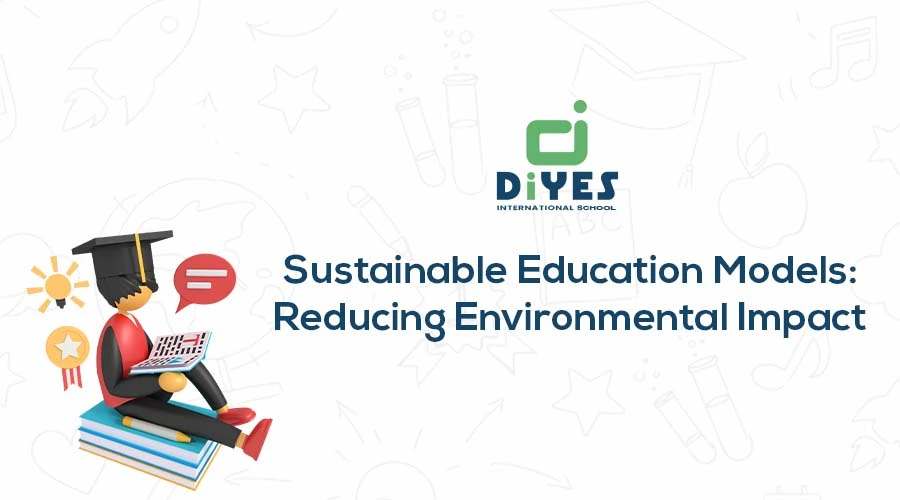In the wake of increasing environmental concerns, the need for sustainable education practices extends beyond industries to encompass education. Sustainable education models are emerging as a vital approach to minimize the environmental impact of educational institutions while instilling ecological awareness in students. This blog explores the significance of sustainable education models in reducing environmental impact and highlights key strategies for implementing such models effectivel

With environmental degradation becoming a pressing global issue, the education sector must adapt to more sustainable education practices. Sustainable education models not only minimize the environmental footprint of educational institutions but also educate students about environmental stewardship. This blog delves into the importance of adopting sustainable education models and offers insights into practical strategies for implementation.
Importance of Sustainable Education Models
Sustainable education models prioritize environmental conservation and promote responsible resource management within educational institutions. Promoting sustainability in education is crucial for nurturing eco-consciousness among students and addressing environmental challenges effectively.
- Environmental Conservation:
Sustainable education models are vital for the preservation of natural resources and ecosystems. By implementing energy-efficient practices, waste reduction strategies, and eco-friendly initiatives, educational institutions can minimize their ecological footprint and promote environmental conservation effectively. Additionally, by incorporating lessons on biodiversity and habitat preservation, students develop a deeper understanding of their role in protecting the environment for future generations.
- Educating Future Generations:
Integrating sustainability principles into the curriculum and incorporating hands-on eco-friendly activities is essential. Such measures instill environmental awareness and responsibility in students, empowering them to become environmental stewards and advocates for sustainable living from a young age. Moreover, exposing students to real-world sustainability challenges through experiential learning opportunities nurtures critical thinking and problem-solving skills necessary for addressing complex environmental issues.
- Community Engagement:
Nurturing community involvement and collaboration in environmental initiatives is a cornerstone of sustainable education models. Engaging students, educators, parents, and local communities in sustainability projects cultivates a sense of collective responsibility towards environmental preservation and encourages active participation in eco-friendly practices. Furthermore, involving community stakeholders in decision-making processes regarding sustainable practices within educational institutions promotes transparency and strengthens community ties.
- Long-Term Impact:
Sustainable education models contribute significantly to building a sustainable future for generations to come. By nurturing a culture of sustainability within educational institutions and equipping students with the knowledge and skills to address environmental challenges, these models lay the foundation for a more environmentally conscious society with lasting impacts. Additionally, promoting research and innovation in sustainable technologies within educational settings encourages students to pursue careers in sustainability-related fields, further perpetuating long-term positive impacts on the environment.
- Global Citizenship:
Promoting global citizenship and interconnectedness is another crucial aspect of sustainable education models. By educating students about global environmental issues and encouraging cross-cultural collaboration on sustainability projects, schools nurture a sense of solidarity and shared responsibility towards protecting the planet for future generations. Moreover, integrating lessons on social justice and equity into sustainability education empowers students to recognize and address systemic environmental challenges on a global scale, promoting inclusivity and diversity in environmental advocacy efforts.
Sustainable education models are essential for reducing the environmental impact of educational institutions and promoting environmental stewardship among students. By prioritizing environmental conservation, educating future generations, nurturing community engagement, ensuring long-term impact, and promoting global citizenship, sustainable education models pave the way for a more sustainable future. It is imperative for educational institutions to embrace sustainability and integrate it into their core values and practices to create a positive impact on the environment and empower students to become agents of change.
Implementing Sustainable Education Models
Implementing sustainable education models requires careful planning, collaboration, and commitment from all stakeholders within educational institutions. By integrating sustainability principles into various aspects of school operations and curriculum, institutions can create a culture of environmental responsibility and inspire students to adopt sustainable practices in their daily lives.
- Curriculum Integration:
Integrating sustainability into the curriculum ensures that environmental concepts are incorporated into all subject areas.

Develop interdisciplinary lessons that incorporate environmental themes, promote critical thinking about sustainability issues, and encourage students to explore real-world solutions to environmental challenges. Moreover, incorporating project-based learning opportunities allows students to apply sustainability concepts in practical contexts, nurturing deeper understanding and engagement.
- Campus Infrastructure:
Improving campus infrastructure is essential for reducing the environmental impact of educational institutions. Implement energy-efficient lighting, heating, and cooling systems; install renewable energy sources such as solar panels; optimize water usage through rainwater harvesting and water-efficient fixtures; and promote waste reduction and recycling initiatives. Additionally, integrating sustainable design principles into campus renovations and new construction projects demonstrates a commitment to environmental stewardship and serves as a tangible example for students and the broader community.
- Green Initiatives:
Implementing green initiatives helps raise awareness about environmental issues and encourages sustainable behaviours among students and staff. Organize campus-wide sustainability campaigns, eco-friendly events, and recycling drives; establish green clubs or student-led sustainability committees; and create opportunities for hands-on involvement in environmental projects and initiatives. Furthermore, integrating sustainability into extracurricular activities and service-learning opportunities allows students to develop leadership skills and make meaningful contributions to environmental conservation efforts.
- Community Partnerships:
Collaboration with local communities and organizations strengthens the impact of sustainability efforts and nurtures a sense of shared responsibility for environmental conservation. Forge partnerships with environmental NGOs, businesses, and community groups to support sustainability initiatives; participate in community clean-up events and tree-planting drives; and engage local stakeholders in environmental education programs and outreach activities. Additionally, involving community members in decision-making processes regarding campus sustainability initiatives promotes inclusivity and nurtures a sense of ownership and pride in environmental stewardship efforts.
- Teacher Training and Professional Development:
Equipping educators with the knowledge and skills to teach about sustainability is essential for the successful implementation of sustainable education models. Provide professional development opportunities for teachers to learn about sustainability concepts, pedagogical approaches, and resources for integrating environmental education into their teaching practice; facilitate peer learning and collaboration among educators; and recognize and reward teachers who demonstrate exemplary commitment to sustainability education. Furthermore, incorporating sustainability into teacher preparation programs and ongoing mentoring and support systems ensures that educators are equipped to effectively engage students in environmental learning experiences.
Implementing sustainable education models requires a comprehensive approach that addresses curriculum integration, campus infrastructure, green initiatives, community partnerships, and teacher training. By incorporating sustainability principles into all aspects of school operations and curriculum, educational institutions can create a culture of environmental responsibility and inspire students to become agents of positive change in their communities and beyond.
Assessing the Impact of Sustainable Education Models
Assessing the impact of sustainable education models is essential for evaluating the effectiveness of sustainability initiatives, identifying areas for improvement, and demonstrating the benefits of environmental education to stakeholders. By collecting data, monitoring progress, and measuring outcomes, educational institutions can track their environmental performance and make informed decisions to enhance their sustainability efforts.
- Environmental Performance Indicators:
Establishing environmental performance indicators provides a framework for measuring the impact of sustainability initiatives. Develop key performance indicators (KPIs) related to energy consumption, water usage, waste generation, and greenhouse gas emissions; analyze trends to assess effectiveness and identify areas for improvement.
- Student Learning Outcomes:
Assessing student learning outcomes helps determine the effectiveness of environmental education programs. Use pre- and post-assessments, surveys, and portfolio reviews to evaluate knowledge, attitudes, and behaviours related to sustainability; measure changes in environmental literacy and critical thinking skills.
- Community Engagement and Outreach:
Assessing community engagement and outreach efforts evaluates the impact of sustainability initiatives beyond the school campus. Track participation rates in events and activities, measure the reach of environmental education programs, and solicit feedback from stakeholders to assess effectiveness.
- Teacher Effectiveness and Professional Development:
Evaluating teacher effectiveness and professional development ensures educators are prepared to teach about sustainability. Use evaluations, surveys, and peer reviews to assess knowledge, skills, and confidence in teaching sustainability; provide feedback and support for continuous improvement.
- Continuous Improvement and Adaptation:
Continuous improvement and adaptation are essential for refining sustainability initiatives. Regularly review results, identify areas for improvement, and incorporate feedback to adjust strategies and initiatives as needed. Nurture a culture of innovation to address emerging environmental challenges.
Assessing the impact of sustainable education models is critical for evaluating the effectiveness of sustainability initiatives, measuring progress towards environmental goals, and informing decision-making to enhance sustainability efforts. By collecting data, monitoring outcomes, and continuously improving sustainability strategies, educational institutions can maximize their environmental impact and inspire positive change in students, educators, and communities.
Promoting Student Engagement and Empowerment
Promoting student engagement and empowerment is essential for nurturing a sense of ownership and responsibility towards sustainability initiatives within educational institutions. By involving students in decision-making processes, providing opportunities for hands-on learning, and empowering them to take action on environmental issues, schools can cultivate a culture of active citizenship and inspire students to become advocates for sustainability.
- Student Leadership Opportunities:
Providing student leadership opportunities empowers students to take ownership of sustainability initiatives and drive positive change within their school community. Establish student-led sustainability committees, green teams, or eco-councils to oversee sustainability initiatives, plan and organize environmental events and projects, and advocate for sustainability policies and practices within the school.
- Experiential Learning and Project-Based Activities:
Experiential learning and project-based activities offer students hands-on opportunities to explore environmental issues, develop practical skills, and implement solutions.

Integrate sustainability-themed projects and activities into the curriculum across subject areas; engage students in real-world problem-solving tasks, such as designing and implementing waste reduction initiatives, creating sustainable gardens, or conducting environmental research projects.
- Student-Led Awareness Campaigns:
Student-led awareness campaigns raise awareness about environmental issues, inspire behaviour change, and mobilize support for sustainability initiatives within the school community. Organize awareness campaigns on topics such as recycling, energy conservation, water conservation, and biodiversity conservation; involve students in designing and implementing communication strategies, such as posters, videos, social media campaigns, and assemblies, to educate their peers and promote sustainable behaviours.
- Green Innovation Competitions:
Green innovation competitions encourage students to develop creative solutions to environmental challenges and showcase their ideas to a wider audience. Organize competitions, hackathons, or challenges focused on sustainability themes, such as renewable energy, waste reduction, sustainable transportation, or green technology; provide mentorship, resources, and support to help students develop and refine their ideas; and recognize and celebrate innovative solutions that demonstrate potential for positive environmental impact.
- Student-Led Environmental Action Projects:
Student-led environmental action projects empower students to make a tangible difference in their school and community by implementing sustainable solutions to local environmental issues. Encourage students to identify and research environmental issues affecting their school or community, develop action plans to address these issues, and implement projects such as tree planting initiatives, habitat restoration projects, community clean-up events, or sustainable infrastructure improvements.
Promoting student engagement and empowerment is essential for creating a culture of active citizenship and sustainability within educational institutions. By providing leadership opportunities, nurturing experiential learning, organizing awareness campaigns, hosting green innovation competitions, and supporting student-led environmental action projects, schools can empower students to become effective agents of change and advocates for sustainability in their communities.
Conclusion
Sustainable education models are pivotal in addressing pressing environmental concerns and preparing future generations to become stewards of the planet. By integrating sustainability principles into educational practices, institutions not only minimize their environmental impact but also instill a sense of environmental responsibility in students. Through initiatives such as curriculum integration, community engagement, and long-term planning, educational institutions create a culture of environmental consciousness that extends beyond the classroom.
Implementing sustainable education models necessitates collaborative efforts and commitment from all stakeholders within educational institutions. By prioritizing sustainability in curriculum design, campus infrastructure, and extracurricular activities, schools nurture a holistic approach to environmental stewardship. Additionally, partnerships with local communities and ongoing professional development for educators further reinforce the importance of sustainability in education.
Ultimately, promoting student engagement and empowerment is central to the success of sustainable education models. By providing leadership opportunities, experiential learning experiences, and avenues for student-led initiatives, educational institutions empower students to actively participate in environmental advocacy. Through these concerted efforts, sustainable education models lay the groundwork for a more environmentally conscious society, where individuals are equipped with the knowledge and skills to address environmental challenges and effect positive change for a sustainable future.
At DiYES International School, we believe in empowering our students to become leaders in sustainability and environmental stewardship. Through our project-based learning initiatives, and green innovation competitions, we provide opportunities for students to take ownership of sustainability initiatives and drive positive change within our school community. By nurturing student engagement and empowerment, we aim to inspire our students to become advocates for sustainability and make a meaningful impact on the world around them.
For inquiries and further information about our sustainability initiatives at DiYES International School, please visit our website at www.diyesinternational.edu.in or contact us directly at +918547609000.


